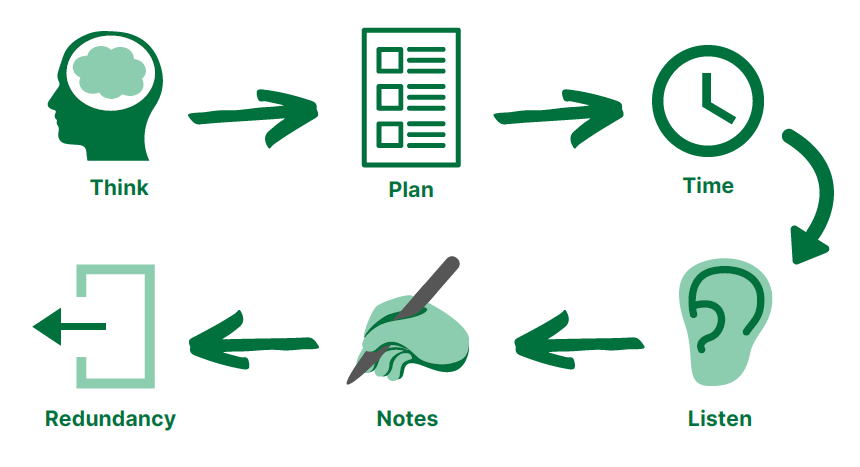4/5 – Trouble Free Redundancy
5 tips for making redundancy trouble-free

Handling redundancies in your business can be hard. But, you can do a few things to make it easier for you and your employees.
Here are my five top tips to making a redundancy process as smooth and painless as possible.
1. Think about where you are and what you want
Every redundancy situation is unique and so there can never be a one-size-fits-all process for completing it. What form your process takes will, to a great extent, be determined by your business’s circumstances.
So, before you start doing anything you should try to understand:
- what you have now and
- what you want or need to have at the end of the process
I know it sounds simple, but so many businesses miss out this point. As a result they lose their way during the process because they either didn’t really know what they had at the start or they didn’t know what they actually wanted at the end.
2. Have a plan!
Once you understand where you are and where you want to be, you can then work out how you are going to get from one to the other.
You can restructure your business in so many ways to cut costs or reduce the number of staff you have. Which route is right for you is going to depend on your circumstances.
 For example, 1) you may need to reduce the number of employees that you have across the board. Or, 2) you may just want to reduce the number or employees that you have in a particular part of your business. Alternatively, it could be that 3) you don’t want to reduce the number of employees that you have at all. Instead, you want to change how they work or how the business is structured.
For example, 1) you may need to reduce the number of employees that you have across the board. Or, 2) you may just want to reduce the number or employees that you have in a particular part of your business. Alternatively, it could be that 3) you don’t want to reduce the number of employees that you have at all. Instead, you want to change how they work or how the business is structured.
These are all potentially redundancy situations but you will need to follow a different process with each one of them to achieve your goal.
Whatever you are trying to achieve, you need to choose a plan that will give you what you want at the end. Produce a time line of when you are going to carry out each step of your plan and follow it through.
3. Leave yourself enough time
As part of any redundancy process you are going to have to consult with your employees who are at risk of redundancy.
You should look to embark upon the consultation process as soon as you know that there are likely to be some redundancies. And, in some cases you will need to have a minimum consultation period of 30 or 45 days.
As part of any consultation period you will need to:
- inform all of your effected employees about the situation
- explain the process to them
- score them if necessary
- look at ways of avoiding redundancy
- discuss potential options with them.
This naturally takes time and rushing it will likely cause you problems!
4. Listen
 As part of any redundancy process you have a duty to consider ways that you can avoid the need to make someone redundant. You will, hopefully, have thought of most ways to avoid the redundancies when you are planning the redundancy process. But, there may be something that you have missed.
As part of any redundancy process you have a duty to consider ways that you can avoid the need to make someone redundant. You will, hopefully, have thought of most ways to avoid the redundancies when you are planning the redundancy process. But, there may be something that you have missed.
Always ask your employees who are facing redundancy whether they can think of any way in which they can avoid redundancy. Listen to what they have to say and then follow-up on any answers given.
You aren’t obliged to implement any suggestion but you are expected to consider them and to explain why you can’t put into effect their suggestion.
5. Take notes
Hopefully everything runs smoothly and you complete your restructure without any disgruntled employees bringing claims against you.
However, sometimes it doesn’t matter how good you are, you just can’t stop someone bringing a claim.

That’s when you will appreciate having taken good notes.
If you followed a fair process and can prove it because you have copies of letters and emails and notes of any discussions, then you should be able to safely defend your position. If you haven’t got anything backing up what you have said, you may have a much more uncomfortable ride.

Download this document as a PDF by clicking here
- 1/5 – Managing Sickness Absence
- 2/5 – Pre-Employment Checks
- 3/5 – Contracts of Employment
- 4/5 – Trouble Free Redundancy
- 5/5 – Choosing the Right HR Support







